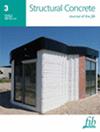Comparative shear performance of ultra high‐performance concrete filled pocket and longitudinal trough connector of PC composite girder with full‐depth deck
IF 3.3
3区 工程技术
Q2 CONSTRUCTION & BUILDING TECHNOLOGY
引用次数: 0
Abstract
Prestress concrete composite girders with full‐depth precast bridge deck panels (PC composite girders) have been widely utilized in civil engineering due to their high production quality, reduced construction duration, potential weight reduction, and lower life‐cycle cost. The interface shear behavior in ultra high‐performance concrete (UHPC)–normal concrete (NC) connection interface of full‐depth deck PC composite girder has been extensively studied. This study conducted seven push‐off tests to examine the shear performance of UHPC‐filled joints between precast I‐girders and full‐depth precast concrete slabs. The testing variables included the quantity, and spacing of the Ubars, as well as the type of UHPC‐filled joints (longitudinal trough connector or pocket connector). The experimental results show the quantity and spacing of Ubars have a significant impact on both the interface shear capacity and residual shear resistance. For continuous shear connectors with reserved notches specimens, the ultimate load of the 4Ubar and 6Ubar specimens increased by 93% and 194%, respectively, compared with the 2Ubar specimens. With the increase of the spacing of the Ubar, the ultimate load will decrease. When the spacing between Ubars increases from 100 to 150 mm, the normalized ultimate load decreases by 51 kN. The type of joints also plays a crucial role in determining the ultimate shear‐bearing capacity of the specimens. The Ubars in pocket connector specimens will provide a greater contribution to the ultimate shear bearing capacity than longitudinal trough connector specimens and the ultimate stress of the 4Ubar and 6Ubar pocket connector specimens are greater than that of the longitudinal trough connector specimens by 232% and 323%. The study introduces the concept of pulling angle. In the experiment, the specimen with a large length is less affected by the pulling force. The experimental results in this study can rarely be predicted well by typical equations developed in current design codes and previous studies. Therefore, a more accurate equation was developed to predict the interface shear transfer stress between precast common concrete I‐girder and full‐depth precast concrete slab with UHPC‐filled joints.带全深度桥面的 PC 复合梁的超高性能混凝土填充袋槽连接器和纵向槽连接器的抗剪性能比较
带全深度预制桥面板的预应力混凝土复合梁(PC 复合梁)因其生产质量高、施工工期短、潜在重量减轻和生命周期成本低等优点,已在土木工程中得到广泛应用。对全深度桥面 PC 复合梁的超高性能混凝土(UHPC)-普通混凝土(NC)连接界面的剪切行为进行了广泛研究。本研究进行了七次推移试验,以检验预制工字梁与全深度预制混凝土板之间的超高性能混凝土填充接缝的剪切性能。试验变量包括 Ubars 的数量和间距,以及 UHPC 填充接头的类型(纵向槽式接头或袋式接头)。实验结果表明,Ubars 的数量和间距对界面抗剪能力和残余抗剪能力都有显著影响。对于带预留槽口的连续剪切连接件试样,与 2Ubar 试样相比,4Ubar 和 6Ubar 试样的极限荷载分别增加了 93% 和 194%。随着 Ubar 间距的增加,极限荷载也会降低。当 Ubar 间距从 100 mm 增加到 150 mm 时,归一化极限荷载降低了 51 kN。接头类型在决定试样的极限剪切承载力方面也起着至关重要的作用。与纵向槽形连接器试件相比,袋形连接器试件中的 Ubars 对极限剪切承载力的贡献更大,4Ubar 和 6Ubar 袋形连接器试件的极限应力分别比纵向槽形连接器试件大 232% 和 323%。研究引入了拉角的概念。在实验中,长度较大的试样受拉力的影响较小。本研究中的实验结果很少能用现行设计规范和以往研究中开发的典型方程很好地预测。因此,我们开发了一个更精确的方程来预测预制普通混凝土工字梁和带有 UHPC 填充接缝的全深度预制混凝土板之间的界面剪切传递应力。
本文章由计算机程序翻译,如有差异,请以英文原文为准。
求助全文
约1分钟内获得全文
求助全文
来源期刊

Structural Concrete
CONSTRUCTION & BUILDING TECHNOLOGY-ENGINEERING, CIVIL
CiteScore
5.60
自引率
15.60%
发文量
284
审稿时长
3 months
期刊介绍:
Structural Concrete, the official journal of the fib, provides conceptual and procedural guidance in the field of concrete construction, and features peer-reviewed papers, keynote research and industry news covering all aspects of the design, construction, performance in service and demolition of concrete structures.
Main topics:
design, construction, performance in service, conservation (assessment, maintenance, strengthening) and demolition of concrete structures
research about the behaviour of concrete structures
development of design methods
fib Model Code
sustainability of concrete structures.
 求助内容:
求助内容: 应助结果提醒方式:
应助结果提醒方式:


